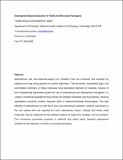Siderophore-based detection of Fe(iii) and microbial pathogens
Author(s)
Zheng, Tengfei; Nolan, Elizabeth M.
DownloadMetallomics-FinalMS-050712.pdf (2.564Mb)
OPEN_ACCESS_POLICY
Open Access Policy
Creative Commons Attribution-Noncommercial-Share Alike
Terms of use
Metadata
Show full item recordAbstract
Siderophores are low-molecular-weight iron chelators that are produced and exported by bacteria, fungi and plants during periods of nutrient deprivation. The structures, biosynthetic logic, and coordination chemistry of these molecules have fascinated chemists for decades. Studies of such fundamental phenomena guide the use of siderophores and siderophore conjugates in a variety of medicinal applications that include iron-chelation therapies and drug delivery. Sensing applications constitute another important facet of siderophore-based technologies. The high affinities of siderophores for both ferric ions and siderophore receptors, proteins expressed on the cell surface that are required for ferric siderophore import, indicate that these small molecules may be employed for the selective capture of metal ions, proteins, and live bacteria. This minireview summaries progress in methods that utilize native bacterial and fungal siderophore scaffolds for the detection of Fe(III) or microbial pathogens.
Date issued
2012-08Department
Massachusetts Institute of Technology. Department of ChemistryJournal
Metallomics
Publisher
Royal Society of Chemistry, The
Citation
Zheng, Tengfei, and Elizabeth M. Nolan. “Siderophore-based detection of Fe(iii) and microbial pathogens.” Metallomics 4, no. 9 (2012): 866.
Version: Author's final manuscript
ISSN
1756-5901
1756-591X